
Please send all Checks and Money orders to :
Dave Taylor P.O. Box 87 Sylvania, OH 43560
419-842-1863
Click Here to E-mail Us!
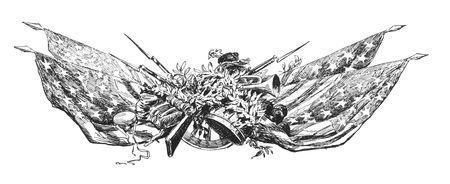
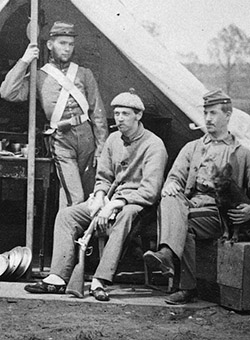
14 11
~~~~~~~~~~~
LAYAWAYS ARE WELCOME:
Need to split your order into multiple payments? No problem! A simple 20% earnest money deposit will hold your item for you.
You can then pay it off in easy installments that fit your budget.
~~~~~~~~~~

14-11-01 … Mint, Mint, Mint Outdoor Mounted View of a Federal Cavalry Trooper with all the Bells and Whistles!
Sharp Outdoor Sixth Plate Tintype. One of those views you could see published on magazine covers or in the Library of Congress collection and you think – I wish I had that! Crystal clear view focusing on a smartly turned out cavalryman paused in the dirt street of an unnamed town, two curious onlookers in the background, one dapper in a top hat, the other more working class in fashion, watching the operation from in front of a brick house. The photographer has focused his lens on the dashing, young, clean-shaven trooper and his horse, giving us an incredibly detailed view: He is posed in profile, slightly turned toward the camera, feet deep in hooded stirrups, sitting an 1859 McClellan with the overcoat straps twisted and knotted behind, a pair of McClellan saddle bags hanging from the rear, even a crupper fixed as well. He is armed with an 1840 pattern heavy cavalry saber- the characteristic grip shape is plain as day- with a leather saber knot affixed to the guard. The trooper is in profile, showing his slanting forage cap with a glimpse of brass insignia on top, and appears to be wearing white dress gloves. The shoulder strap for his saber belt is in place, and he seems to have a white shirt collar showing above the collar of his mounted jacket whose brass buttons have been lightly gilded by the photographer. The smartness of his attire and equipment are striking. A very fine piece of Civil War photography. Superb condition and clarity housed in a half case
… $1,975.00 SOLD
Click Here to E-mail Us!
Call us @ 419-842-1863

14-11-02 … Wonderful Captured Yankee Field and Staff Sword Converted to a Confederate Officer’s Sword! …
To use an old expression: this sword is “the nuts!” Super condition, absolutely dead real, honest-to-god Federal US presentation-grade field officer’s saber made by Emerson and Silver that made its way into a Confederate officer’s hands, who then had it altered to suit its new national loyalty. This surfaced many years ago and has been in the collection of one of the officers of the Maryland Arms Collectors Association since then. He sold it to me this year. I am darn happy to have it and offer it on a list. Emerson and Silver began making swords with the beginning of the war, so it is unlikely this belonged to a former Federal officer who left the Union when his state seceded, but it is possible. More likely, the Confederate captured this sword somewhere from an unfortunate Yankee, and then had it “Confederatized”. This is one of Emerson and Silver’s high grade presentation swords with deeply cast and chased mounts and silvered grip. The firm name is very legibly etched on the ricasso. What makes this sword so wonderful is… The rebel officer had a jeweler or military goods maker remove the cut-out “U.S.” in the counter-guard and replace it with a beautiful, professionally done, C.S. with matching forked ends on the letters. Striking! The blade is exceptionally clean, in the bright, with just flecks of gray here and there, and very legible etched panels on either side. Here, too, the Rebel modified his weapon by having the etched “US” buffed out of the floral etched cartouche. The scabbard with its deeply cast and chased brass mounts with eagles, shields and floral designs is excellent, and still preserves one of the sword sling swivels in the upper carrying ring. Both scabbard and mounts have an aged patina and show some dirt and minor stains. I have left them undisturbed. A rectangular spot on the scabbard was masked one time by the previous collector’s “label-maker-label” which I removed. It shows brighter in that spot and should be gently oiled and rubbed. I have left the collector’s painted inventory numbers on the blade and scabbard, but they can be easily removed if you choose. The Confederate owner also made one last small change in the scabbard mounts. On this pattern sword, Emerson and Silver always included a small raised “U.S.” inside a foliate scroll beneath the throat on the upper scabbard mount. The rebel owner had the offending letters removed and “CSA” deeply incised on a stippled background in their place. Every reference to “US” is removed from this sword! Rarer than most Confederate carried southern made officer’s swords and much prettier, this is a screamer display item. All in all, a wonderful, historic piece that carries its history in full view. In my personal collection I have an Ames foot officer’s sword housed in a custom made Boyle & Gamble scabbard captured in Virginia and brought home by a 20th Michigan officer. My sword also has the US buffed out of the blade and has the rebel’s initials inscribed on the pommel, and the capture date inscribed on the scabbard mount. The scabbard on mine was custom made in Richmond to accept the longer US blade and is otherwise EXACTLY the same as a B&G staff scabbard. It is an example of B&G making a scabbard for a captured US sword. Finding a real Confederate altered US sword is a rare treat. Here is one of the best I have seen in over 40 years of looking … cc
… $7,500.00 SOLD
Click Here to E-mail Us!
Call us @ 419-842-1863
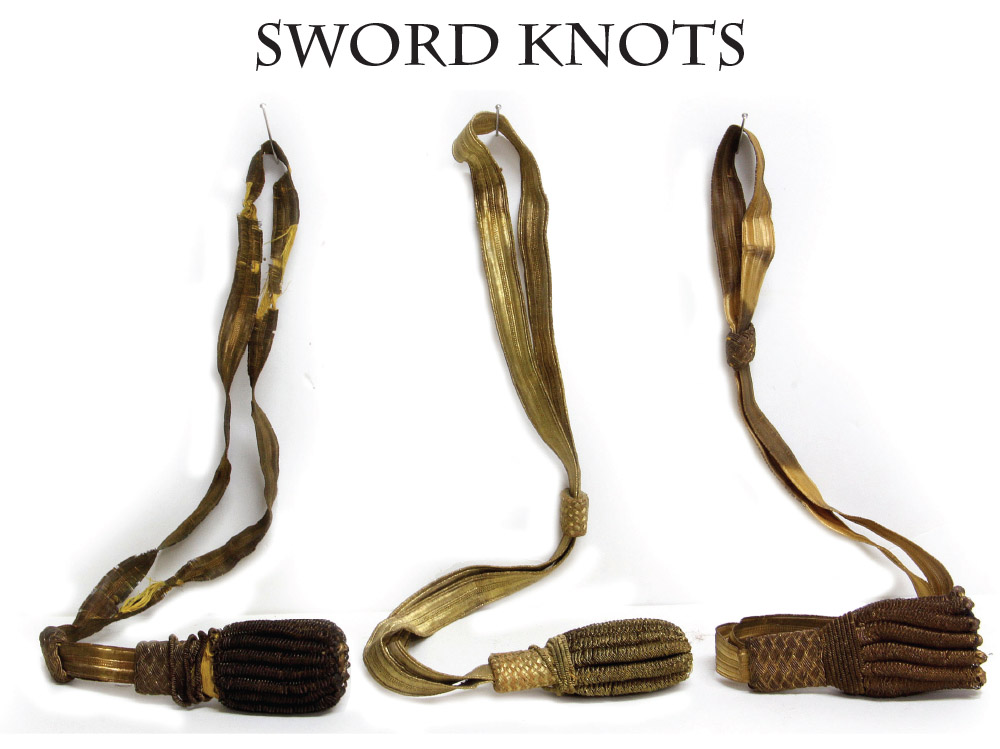
Three Gold Bullion Officer s Sword Knots …
Three slightly different Civil War officer s sword knots. Like the officers swords themselves, their sword knots were all privately purchased and commercially available from military goods dealers who supplied different types that conformed generally to regulations. An officer might use a leather knot in the field, but dress regulations specified gold bullion and here are three with the required strap, turks-head knot and tassels, but varying slightly. Please see the photos for condition:
14-11-03 … Sword Knot (LEFT) …
worn but atill usable … a
… $85.00 SOLD
14-11-04 … Sword Knot (CENTER) …
very good showing light handling … a
… $150.00 SOLD
14-11-05 … Sword Knot (RIGHT) …
excellent showing very little handling … a
… $175.00
SOLD
Click Here to E-mail Us!
Call us @ 419-842-1863

14-11-06 … Untouched Civil War Ames 1840 Pattern Light Artillery Saber …
Regulation 1840 pattern saber for light artillerymen. These were meant as last resort weapons for the mounted drivers and NCOs in a light artillery battery. They show up in two types: one where the scabbard lacks a throat and seats in a recess on the underside of the guard, and another like this one, with the more conventional scabbard throat and sealing pad at the blade shoulder. Ours is clearly marked and dated: Made by Ames Mfg. Co. Chicopee, Mass. and US/ ADK/ 1865 on either side of the ricasso. Blade is VG and shows bright areas under light and dark gray sections. It might brighen up a bit with a careful cleaning. Like the blade, the scabbard and hilt are untouched. The scabbard showing faded bright finish now as a dull silver mixed with gray areas, no dents or dings. The hilt is likewise undisturbed: original twisted brass wire over original leather showing just honest wear and abrasion on the high spots, brass pommel and knuckle guard with a darkish mellow patina. It is hard to find one these days that has not been messed with. Straight out of the attic …
qe+eldrdg
… $795.00 SOLD
Click Here to E-mail Us!
Call us @ 419-842-1863

14-11-07 … Superb Tagged Confederate Tin Drum Canteen w/ strap Donated to a Warsaw, Indiana, G.A.R. Post by the Son of Lt. Hiram F. Berst, 6th Iowa Cavalry, as a Memento of his Father …
Superb Confederate tin drum style canteen measuring a fine large eight inches in diameter with tall tin spout, three strap brackets, and an original carrying strap improvised from saddle blanket roll strap, broken now but still retaining its buckle. Wonderful GAR Post label glued on one side bears a period ink inscription on the right hand side reading Donated to / Henry Chipman [Post] / by / Fred C. Ber[st] / as a memento of [my or his] / father / Hiram F. Ber[st] / May 11/87 The Henry Chipman Post was formed in 1886 by a breakaway group from the first GAR post in Warsaw, the Kosciusko Post, and the two remained separate until 1916. The label, in fact, is a piece of stationery from the earlier post: the name Kosciusko is visible on a cartouche on the US flag printed on the document, and a set of General Orders is also printed thereon and dated 1882, the year that post was founded. The orders are signed N.C. Welch, who is Nate C. Welch, that post s first commander. The flag, and orders are deeply faded and stained but can be seen.
Our History Detective (The historian Steve Rogers of Ithaca NY), can kick sand in the faces of those TV amateurs. He researched exhaustively and conclusively established the names of all the people mentioned on the tag. Hiram F. Berst (the man whose memory is being honored by the presentation of the canteen) lived in Kosciusko County, Iowa both before the war (he s in their 1860 census) and after the war (he s in their 1879 list of veterans). He had a son Frederick C., born in 1858 (the donor of the canteen in 1887). The elder Berst was in Marion, Iowa, when he enlisted at age 33 as a Second Lieutenant in Co. K 6th Iowa Cavalry. His commission dates to the same day and he served with the regiment until muster out 10/17/65 at Sioux City. The regiment served on the frontier fighting the Sioux. His company at one point garrisoned Fort Randall, Dakota Territory, and he mentioned as a Post Quartermaster at Fort Buford. The story on the tag suggests that the canteen was originally captured by Dan Chapin of the 12th and 138th Indiana. It further seems to contain a private joke about being captured and recaptured by GAR comrades in the twenty years since the war. Noting that there were two GAR posts involved in the ownership of this relic, therein likely lies the story of the recapture joke . The precise wartime and postwar history of the canteen hinges on a missing word in the inscription on the upper left side of the label. The bottom inscription is clear: Recaptured [J]une (?) 17 1883 /E.M. Chaplin/Q.M. Post 114 G.A.R. Post 114 was the Kosciusko Post, and Chaplin was one of the founding members, having served in the 7th Indiana Cavalry for two years and mustering out as a corporal. The canteen obviously made its way into his hands after being lost earlier.
The key is the missing word of the upper part of the inscription, which reads: by / Dan Hamlin /at Elkhart Reunion /1882. If Hamlin, who served in the 12th and the 138th Indiana Infantry, captured the canteen at the Elkhart reunion, then it might have belonged to Berst, whose son later donated it to the other post after Chaplin retrieved it. If, on the other hand, the canteen was lost by Hamlin (and later recovered by Chaplin in either case), then it may have belonged to Hamlin in the first place and simply made its way into Berst s hands over the years through Chaplin. Berst was active in raising funds for the reunion of another county regiment in 1886, so he seems to have been an active GAR man in general. In any case, when the Kosciusko Post split in 1886, Chaplin defected, to become the first commander of the Chipman Post, and it seems Berst went with him, since his son later gave the canteen to that post. In any case, if the canteen was brought back by Hamlin the Hoosier, he could have obtained it during his service as a private with the 12th Indiana from 5/7/61 to 5/19/62, or in the 138th as Captain from 5/18/64 to 9/30/64. The latter regiment served for a hundred days doing railroad guard duty in the Nashville area, keeping Sherman s lines of communication open. The former regiment was a one-year outfit that served in Banks Army of the Shenandoah, doing picket and outpost duty by companies, with frequent skirmishes, in the area of Williamstown and Winchester, Va.
Whichever soldier brought it back, it is a very cool 100% Reb canteen with a great looking G.A.R. display label and interesting story. I bought this canteen several years ago from a Detroit picker . I kept it intending to solve the puzzle on the label. But until I asked Steve Rogers to help I was in the dark. Much more data can certainly be found. One of the most intriguing CS canteens I have owned
… $2,950.00
Click Here to E-mail Us!
Call us @ 419-842-1863

14-11-08 … A Stand-out Condition Blade on This Inscribed Ames 1850 Pattern Foot Officer s Sword:
PRESENTED BY Wm. TRYON FOR USE OF THE ADJUTANT … We have seen presentations to an individual officer. Here is an example of a presentation to a regiment for the use of its adjutant. Excellent condition example of an early war Ames foot officer s sword with vivid etching showing much original frosting, traces of gilding on the mounts, boldly engraved, Presented by Wm. Tryon for use of the Adjutant. This sword likely dates late 1850s to 1861. The sword retains its gold bullion sword knot and the black leather scabbard with brass mounts is solid. The upper mount retains about 20 percent of its gilding and opposite the inscription has the Ames company address stamped lengthwise. The other mounts have little gilt remaining, but match in tone. The guard has a matching nicely toned patina with deep floral engraving at the pommel cap. The grip is super, with full wrap and wire, the grip showing the characteristic Ames grip seam curving down from the pommel on the inboard side. The blade is impressive even from across the room: bright with vivid etching that retains most of its frosting, just a few light gray areas near the tip and some gray on obverse ricasso that obscures the firm name. The floral sprays and U.S. on the reverse are sharp, and the eagle and sprays on the obverse are clear. The E Pluribus Unum motto is dry needle engraved. The etched U.S. on the other side shows the early thin US letters with delicate serifs. The presentation to a position in a regiment rather than an individual would seem to indicate a very early war or pre-war donation to a militia or newly formed volunteer unit by a wealthy individual. The idea being that a militia unit might change staff officers frequently but the arms would be retained in an armory for their use, or that a regiment was still being formed when the gift was made and no officer had yet been appointed to the office. In either case William Tryon must have been patriotically spirited. A quick look in the 1860 census records does not reveal a ready identification of the donor, but the style of the sword suggests the gift may have been made before 1860, in which case there are many more possibilities among patrons of local militia groups. Of little note, but important enough to mention – the drag of the scabbard, while attached, is loose. Very interesting early war weapon …
s-afjj
… $1,795.00 SOLD
Click Here to E-mail Us!
Call us @ 419-842-1863
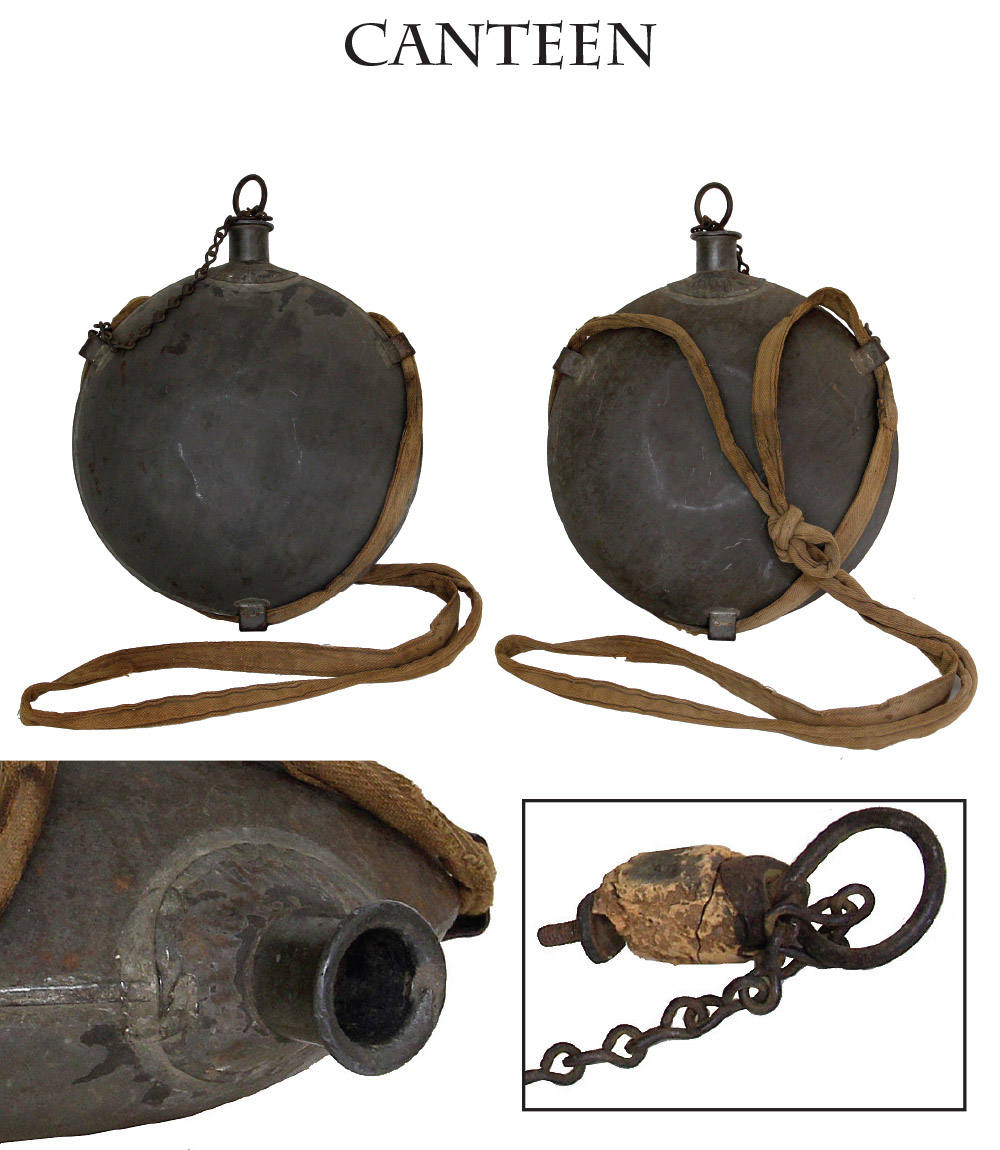
14-11-09 … 1858 Pattern New York Depot Canteen with Original Strap …
Regulation US Civil War canteen. A key piece of the soldier s field gear. This is the New York pattern, characterized by the use of a chain to retain the stopper rather than string or twine. Lacking the cover, but with its original full length linen strap. These were sewn in place on the canteen and adjusted by the simple expedient of knotting the strap. Ours is the smooth-sided pattern and shows a depression in the raised center of each side from riding on the soldier s hip. The cork shows some deterioration, but is largely there. The ring, chain, and brackets are fine. The surface of the tinned iron body has oxidized to a dull gray, showing the cover has been gone for a long time, and enough photos show that after repeated dunkings in muddy streams and creeks, many probably ended up without covers during a campaign anyway. A nice solid example looking just like it did when the veteran returned home and hung up his gear
… $265.00 SOLD
Click Here to E-mail Us!
Call us @ 419-842-1863

14-11-10 … Ohio Civil War Album:
Signed cdv Gov. Brough & Soldier of the 51st O.V.I. … Nicely preserved photo album, bound in leather with gilt brass clasps and binding edge to imitate a book on a shelf, gilt blind stamped Photographs on the spine. Ten gilt edged leaves, with a typical nineteenth century mixture of family photos mixed with images of the famous along with generic scenes. President Lincoln is represented in a CDV engraving, as are George and Martha Washington. Tom Thumb with wife and baby are present, and there is a generic engraving of an old coot tormenting a child by dangling a watch in front of him. The meat of the album is a signed cdv of Ohio Governor John Brough, an Ohio pro-Union and anti-slavery war-democrat who defeated the troublesome copperhead Clement Vallandingham in 1863 and served from January 1864 until his death in office in August, 1865. His election was taken by many as a confirmation of Lincoln s war policies and a preservation of the Union by keeping Vallandingham out of office and Ohio in the war. In addition to Brough, there is a signed CDV of Charles R. Leslie, opposite a tintype of a child who bears a resemblance to him. Leslie is shown in a vignette bust view with military jacket or frock coat unbuttoned to show a vest underneath. Leslie enlisted as private in Co. A 51st Ohio on 9/7/61, at age 26, and mustered in 9/17/61. He served the entire war, being mustered out for disability only on 6/5/65. The 51st saw a lot of action in the Army of the Ohio and Army of the Cumberland, mainly in the 14th, 21st and 4th Army Corps. They lost 4 officers and 108 enlisted men killed or mortally wounded during their service, fighting at Stones River, Chickamauga, Missionary Ridge, Resaca, Kennesaw, and Nashville, among other places … 1ycjjot
… $575.00
Click Here to E-mail Us!
Call us @ 419-842-1863
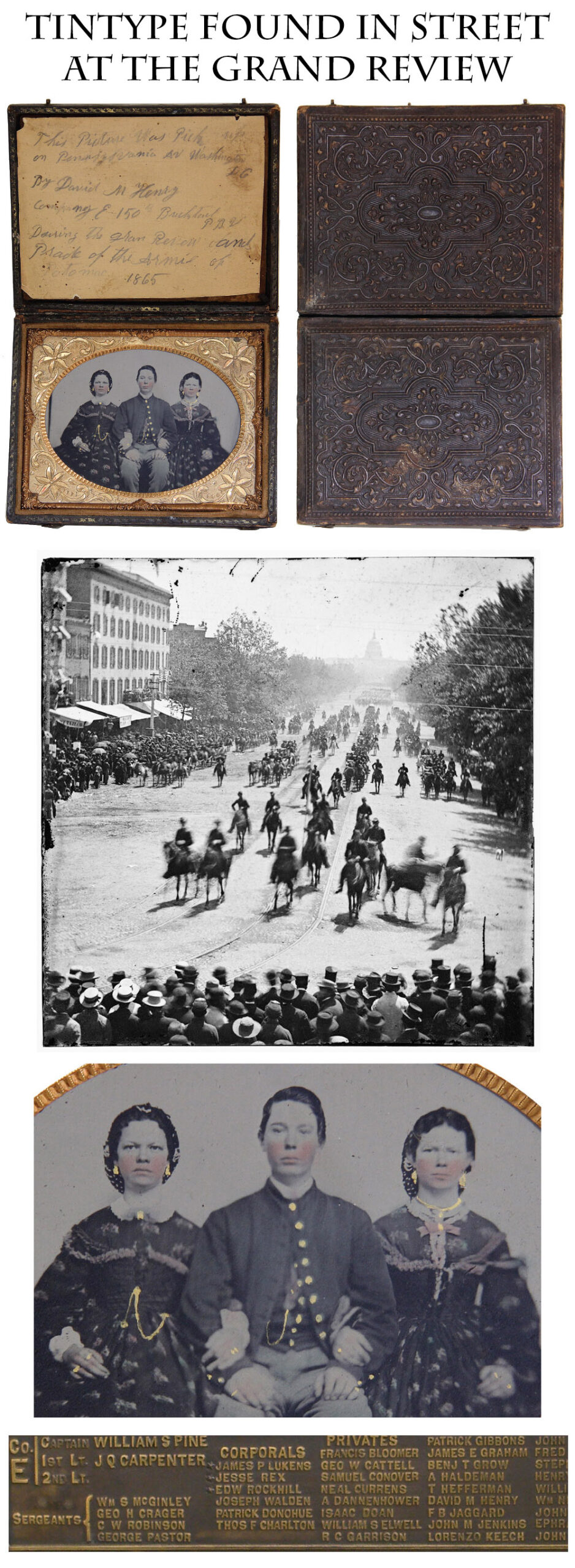
14-11-11 … Tintype of Gentleman and his lady friends …
A Most Unusual Relic – A Pennsylvania Bucktail’s relic of the Grand Review: QUARTER PLATEuarter plate Tintype of a soldier and sisters (?) Very clear quarter plate tintype in leatherette case with mat, glass, etc., showing a seated private between two young ladies, arms entwined, looking somewhat formal in their neutral expressions ( I thought of titling it soldier and gal pals at first, but from their expressions I doubt they would have approved.) Their cheeks are delicately tinted red and some of their buttons and jewelry have been lightly gilded. The girls wear dresses of similar pattern, have similar facial features, and are likely the soldier s sisters, posed with him before he heads off, or back, to war.
Unfortunately, whoever possessed this photo while standing in the Washington streets watching the armies march past in the Grand Review in May, 1865, lost it. The story was penciled on a piece of paper pasted to the facing pad in the case: This picture was pick up on Pennsylvania Av Washington DC By David M Henry Company E 150th Bucktail PBV During the gran Revew and Prade of the Armie of Potomac 1865 . Henry s spelling and handwriting leave something to be desired, but the meaning is very clear. The initials PBV are likely Henry s abbreviation for Pennsylvania Bucktail Volunteers. The 149th and 150th Pennsylvania regiments were sometimes called the bogus bucktails by the members of the original 13th Reserves, who originated the name. Henry was actually serving in the Veteran Reserve Corps when he found the photo, which probably explains why he was not in the parade itself, but he has some interesting history. He enlisted in the 150th on 8/19/62 at Philadelphia as a private in Co. E and served until about 10/1/64, when he transferred to the VRC until muster out 8/19/65. The Bucktails are famous enough not to need much detail here: They were hard fighting and lost 4 officers and 108 men killed and mortally wounded during their service. Henry would have been with them in the First and Fifth Corps all the way from Chancellorsville to Petersburg, and we can confirm he was present with his company on the field at Gettysburg: His name appears among the participants on the state monument on the battlefield, where they lost heavily in the first day s fighting on July 1. A very cool memento kept by a veteran who had seen the elephant and was also present to see the victory parade in Washington celebrating the war s end. As for the soldier in the photo, his story remains untold. We can assume he regretted the loss of the photo at The Grand Review, never knowing that the finder recorded the event for posterity. Neat relic … bjj and bgex
… $450.00 SOLD
Click Here to E-mail Us!
Call us @ 419-842-1863
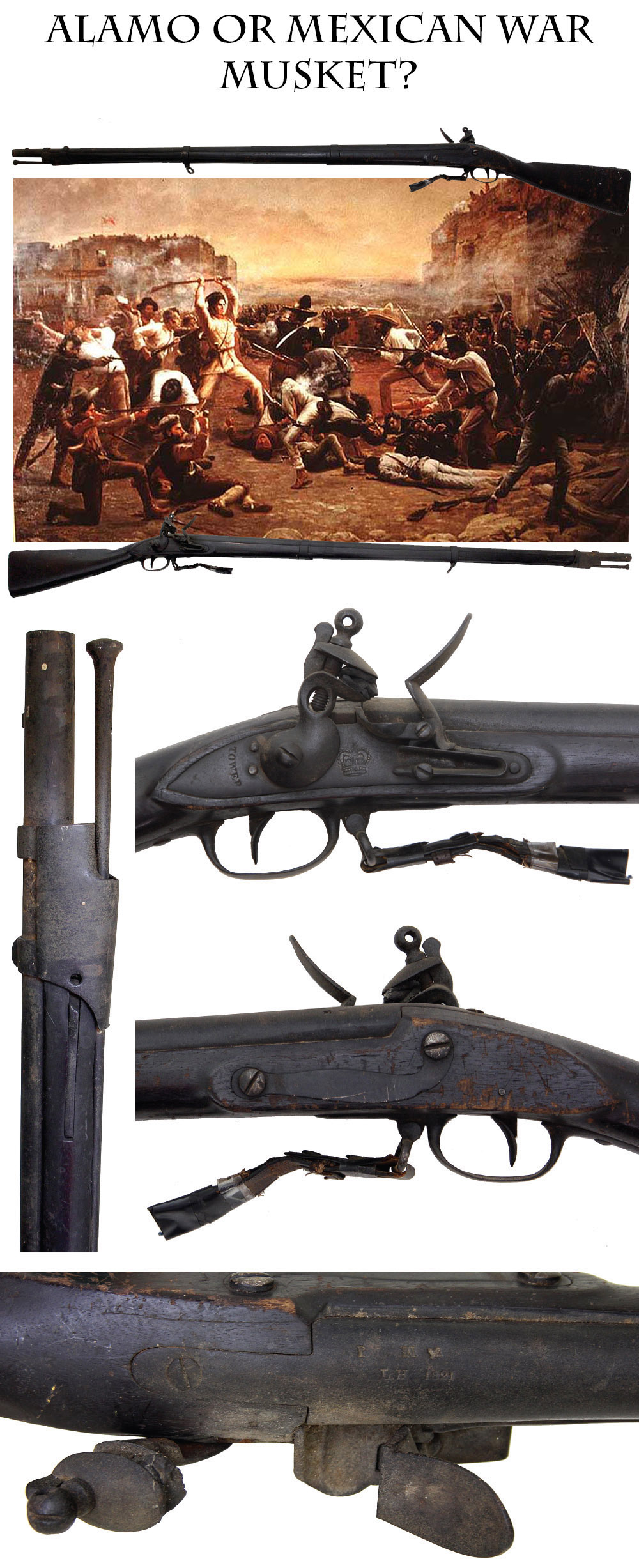
14-11-12 … ATTIC CONDITION ALAMO ERA OR MEXICAN WAR SOUVENIR?
British Tower marked commercial lock in an 1816 US type military musket untouched since the period of use — 1820s to 1840s. … This gun surfaced last month at a New England auction and was freshly found. It was such an appealing mystery I had to buy it! 100% original, 100% complete, original flintlock ignition, and mechanically perfect. Completely untouched and fresh out of a New England attic, the gun is straight, and intriguing. It follows the pattern of a US 1816 musket to the letter except for the lock. It has no US markings, and has a British Tower marked lock that fits it perfectly! The steel parts (except lock) appear to be regulation US M1816. The lock is English commercial. The stock is an arsenal made piece made expressly for these US and English metal parts and follows the lines of the US-M1816 perfectly including no comb on the stock. All the wood to metal joins are as tight as any I have seen, and as good a quality as any US contract or arsenal arm! Wood is very good, strong edges, just minor handling marks and scratches, some abrasions at the edges aft of the sideplate, metal is an even smooth brown overall, just a little crusty at the muzzle, in the upper band and top of the ramrod. Swivels, bands, ramrod (M1816 pattern) in place, just the little stand-up tip on the upper band spring gone. Mechanically good. The barrel bears several proofs at the breech. These proofs appear to be US marks. The initials LH and the date 1821 are clear in the center of the barrel. Above them is a large P that I take to be Proved and then either a W or more likely an M . There is also a very deeply stuck X next to it which I will address below. The lock is clearly marked with British commercial marks: Tower behind the hammer, and a crown forward, but lacking any broad arrow or other government ownership marks. There are no other marks at all on the musket! My best hypothesis is that we are looking at a British commercial musket sold to Mexico and brought back as a souvenir by a US soldier from New England. I theorize that a gun broker assembled this musket using condemned US steel parts, a British lock, and stock of new manufacture circa 1821 to 1830s. Mexico purchased tens of thousands of flintlock muskets from British sources starting in 1821, when they gained independence from Spain. American testimony from the Mexican war mentions lost enemy muskets with Tower marked locks. The deeply struck X on the barrel looks very much like a US condemnation mark, and it is hard to escape the feeling that the barrel was rejected by entity and then made its way into the commercial market to be mounted and sold to someone less picky, such as the Mexicans. In short, we have a tightly assembled military musket with a British commercial Tower lock of the right period for purchase by the new Mexican state, but no matter what the story works out to be, it is one darn interesting musket that is as honest and untouched as anyone could hope to find … hej
… $1,750.00
Click Here to E-mail Us!
Call us @ 419-842-1863
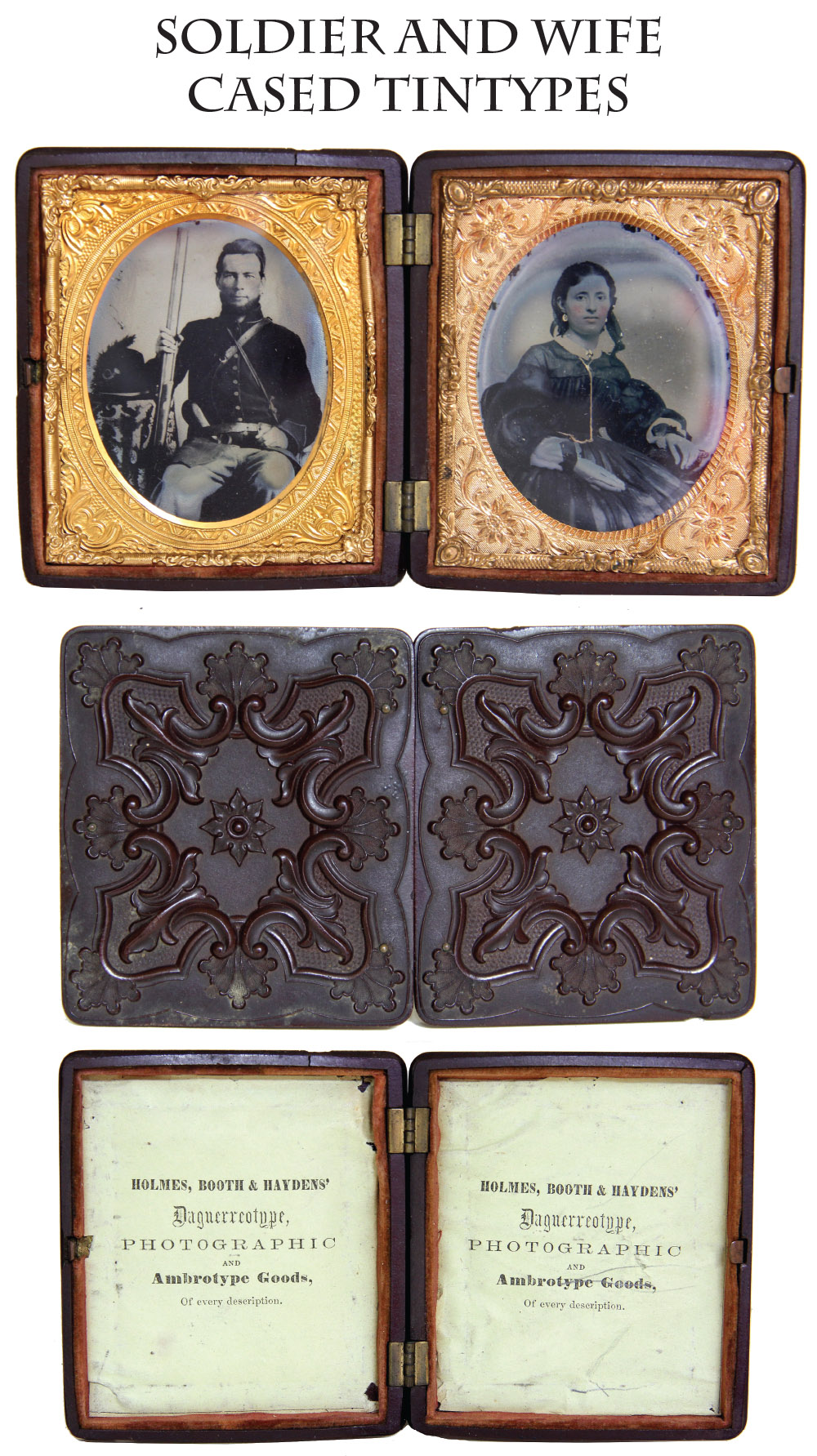
14-11-13 … Cased Pair of Tintypes: Early War Armed Infantry Soldier and Wife:
Nice pair of tintypes ca. 1861 1862, showing a soldier and a woman, presumably his wife. Both are 2/3 length seated views. He wears an infantry enlisted frock coat and has his M-1858 Hardee dress hat with and infantry horn and feather sitting on a table next to him. The photographer has apparently supplied him with a half-stock Kentucky rifle to pose with and a strapped flask and hunting bag. These are the straps we see. It is possible the Yank brought the rifle and accoutrements to war but generally such civilian pieces were weapons supplied by the photographer to add excitement to the portrait, usually in very early war photos. (Noting the ultra tall collar on the coat this too indicates a very early war image.) In any event he looks like a serious customer. His wife wears a billowing dress with earrings and jewelry that are lightly gilded, and the photographer has lightly tinted both individuals cheeks. A little bit of solarization around him, mostly on the right. She is more closely surrounded by it but is still fairly clear and attractive. Housed in a Holmes, Booth and Hayden thermoplastic photographic case with geometric and floral motifs, brown tones, slight crack upper right inside edge of one half, some dirt exterior lower edge on one side. This image was once part of the Bill Prince collection of Lansing, Michigan. He was a good friend and has been gone a long time now … bbj
… $395.00 SOLD
Click Here to E-mail Us!
Call us @ 419-842-1863

14-11-14 … Maryland Officer’s Sword! Horstmann 1850 Pattern Foot Officer’s Sword! Inscribed to Kennedy Butler, Second Regiment Infantry Maryland Potomac Home Brigade:
Maryland was the quintessential border state, furnishing regiments to both sides in the Civil War. Here is a beautifully documented 1850 Pattern foot officer’s sword clearly engraved inside the counterguard with the officer’s name in wonderful period script, “Kennedy Butler.” There is no ambiguity in identifying the officer: he was a native Marylander who remained loyal to the Union and served in the Second Regiment of Maryland’s “Potomac Home Brigade.” The regiment served in Western Virginia under Generals Kelly and Lander, where it found itself sparring with Stonewall Jackson’s men. It then served under Hunter during his advance on Lynchburg. They were engaged in a number of fights and skirmishes, losing ten killed in battle during their service, being engaged at Springfield, Blue House, Charlestown, Lynchburg, Snicker’s Gap, among others. Kennedy H. Butler enrolled as a First Lieutenant at Cumberland, Md., on 8/31/61, his commission dating the same day, and was appointed acting Quartermaster of the regiment and for a time was detailed to brigade staff as Acting Assistant Quartermaster and Commissary of Subsistence in 1863 and was also posted back to Cumberland, Md., for a time as post Quartermaster. He mustered out 10/4/64 after his term of service expired. He returned to Cumberland, where he operated the Butler Furniture Company, which produced Victorian style furniture that is currently highly sought by antique collectors in western Maryland. His son, Wright Butler, became a well-known architect, building the Allegheny County Court House and a number of other structures in the Cumberland area.
The sword is untouched, with the remains of an ancient paper label on the scabbard bearing the owner’s name which ties the scabbard nicely to the inscribed sword. The scabbard itself is solid, with some alligatoring and loss to the finish and darker patina to the brass mounts, but this seems honest use. I notice a small rivet was added to the upper mount on one side, probably to secure the leather from slipping during its period of use. The hilt matches in color, with an undisturbed aged patina to the brass and some spotting, but a very legible inscription around the interior edge of the guard. The sharkskin wrap is complete, but the wire is only partially there, a few inches attached from the top. The blade is etched, with clear Horstmann and Sons Philadelphia etching at the ricasso, “Proof” on the back edge, and the usual floral motifs etched on either side with a US centered on one side and an eagle with ribband above it on the other. The blade shows a mix of dull silver and darker gray, with a darker area about 2/3 the way down the blade on either side. This is a nice memento of a man who came forward to serve at a critical period in the nation’s history. I notice there is even a biography in a county history, that I am unfortunately not able to access online. More information is certainly waiting to be uncovered
… $2,200.00 SOLD
Click Here to E-mail Us!
Call us @ 419-842-1863

14-11-15 … Rare half Plate Tintype of a Union Cavalryman in a Scarce Thermoplastic Wall Mount Frame with Drawn Revolver Carelessly Pointed right at us …
Half plates are a rare and highly desirable size. It is the largest size tintype that retains the clarity of the smaller sizes. Our man looks pretty serious and is posed seated next to a table with a typical Victorian patterned table cover. He wears a low collared mounted jacket trimmed per regulation but with a single button and single strand of piping at his collar, as opposed to the two buttons and two strands we normally see. Interestingly he sports several officer s accoutrements. He has an officer s belt rig (worn upside down, to get the strap position right for the reversed image of the tintype), Also, the sword is an 1850 foot officer s example hooked to the sword slings with commercial snap hooks. Despite all that fancy stuff, he seems rather at home dangling a 51 Colt Navy across the table toward the cameraman and the viewer. We prize photos showing men with their arms, few of them display their weapons of war so openly to the camera. A very nice presentation given the format and wall mount frame, and even more desirable in the rare half plate size. Overall VG condition with good clarity and contrast and some light age toning
… $695.00
14-11-16 … 15th Iowa Soldier’s Corps Badge … Superb Jeweler Made 15TH Iowa Soldier’s Identification Disk With Seventeenth Corps Badge Design:
Excellent example of a jeweler made Civil War corps badge/identification disk. There are tons of fake corps badges and insignia on the market. Every joker with a Dremel tool seems to be trying his hand at swindling collectors. The on-line auctions, even the most famous, are infested with such items and the site officials fail to remove the bogus listings. The auction officials depend on a small group of uniformed, self appointed experts who have volunteered their services to help vet the auctions. Sadly these experts have allowed hundreds of fake corps badges and CW hat insignia to be sold with impunity. I could type pages on that crap. At any rate, here is a real one. The jeweler took an 1832 dated US silver half dollar, planed the obverse and beautifully engraved W.M. Scott over the arrow emblem of the 17th Army Corps, over Co. E and 15th Iowa Vol. He then affixed a small suspension loop at the top for the soldier to affix it to a chain or suspension device. (Don t get me started on how the soldiers wore these: they were not doughboys stringing them from their necks – they were generally pinned to the coat or carried on a watch chain.) The owner was easily found in the records, though the engraver placed the letters W.M. on the badge instead of Wm. (A frequently encountered annoyance when researching manuscript records, engraved artifacts, etc. … )
William A. Scott is our man (ie: WM Scott). He was from Keosauqua, Iowa, and enlisted in Co. E of the 15th Iowa as a private on 8/3/62 and mustered in the same day. He mustered out on 7/24/65 at Louisville. After the war he lived in Ellsworth and Olathe, Kansas, was a member of GAR Post 68 in Olathe, and lived at least until 1911, when he celebrated his 73rd birthday. The regiment served in the District and the Army of West Tennessee, and then the Department of Tennessee, in the 13th and 16th Corps, before joining the 17th Army Corps in January, 1863. They saw a lot of hard fighting, losing 8 officers and 118 enlistedmen in killed and mortally wounded alone. At Shiloh they lost some 22 killed. Shortly after Scott joined in August, they lost another 14 killed at Corinth and then a series of on-going losses, particularly in the 1864 campaign at Kennesaw and Atlanta. CWdata included some 61 data entries for dates at which they suffered killed, wounded or captured. Western unit corps badges and identification disks are very tough to find and this is a spectacular one executed by a professional jeweler, and even more desirable with the 17th Corps arrow as the central motif
… $1,250.00 SOLD
14-11-17 … Right Out of the 1864 Schuyler, Hartley and Graham Military Goods Catalog! …
These collapsible camp candlesticks are illustrated clearly in the SH & G 1864 catalog of military goods they had for sale. Two concave circular brass bases each have a removable short candle stick. When taken apart the upright sections are stored in the edge of bases, which are then screwed together to form a donut form carrying case. Officers had to purchase all their gear privately and little conveniences like this made their winter huts and office tents much more tolerable. I have owned several such sets identified to officers in the Union army. Excellent condition. Getting harder to find
… $295.00 SOLD
14-11-18 … Fine 1860s Period Tinned Iron Camp Cup …
A nice addition to an officer s display. This short tinned iron cup shows a folded and soldered construction that was common in the period. Measuring four inches in diameter, this would be a typical privately purchased item for camp use. The name FANNIE has been professionally stamped on the face of the cup below the rim— Wasn t that George Custer s nickname at West Point? A great period drinking cup
… $165.00 SOLD
Click Here to E-mail Us!
Call us @ 419-842-1863

14-11-19 … US Model 1842 Springfield Musket …
The last of the .69 caliber U.S. muskets and the first of the percussion long arms for general issue to infantry, though still intended to spew out buck and ball rounds at the enemy. These are key pieces in US martial arms development. One innovation in the 1842 Pattern Percussion Musket was its use of fully interchangeable parts. Another was its production at both the Springfield and Harpers Ferry Armories. Here is an example with a Springfield 1848 dated lock and a Harpers Ferry Barrel. Overall VG condition. Most markings are clear. The eagle forward of the hammer is too light to make out, though the Springfield and 1848 date behind the hammer are sharp. The barrel has been gently cleaned to a light silvery gray and shows minute salt and peppering that is not obtrusive. There is deeper pitting at the muzzle forward of the nose band. Despite the cleaning the barrel shows clear V/P/eagle proofs at the left breach, and just forward of them the Harpers Ferry barrel proof of AR/P for Adam Ruhlman, who was inspecting barrels ca. 1850-52. Rod and swivels, all bands and front site and bayonet stud are in place, the hammer face shows a slight chip, as does the nipple, which sits a bit high and is certainly a replacement. The wood has mixed light brown and darker tones. No cartouches are visible, but a soldier or owner scratched a P into the butt stock and the side flat aft of the side plate. Edges show rounding from actually use, and the wood has numerous age dings as should be expected, but is solid, with no cracks or edge chipping. These guns saw a lot of use early in the Civil War in the hands of volunteers rushing to the battlefield on both sides …
hej
… $1,075.00 SOLD
Click Here to E-mail Us!
Call us @ 419-842-1863

14-11-20 … Rare Rio Grande Camp Knife …
Same as used by Lewis Payne during Lincoln Assassination! These 1860 Texas related and Texas sized Bowie knives have always been highly sought. First is the obvious connection with the Texas market in the title of the knife itself. Second, because Lewis Powell aka Lewis Payne used one to try and kill Secretary of State William Seward on the night of April 14th 1865 at the same time Booth was killing Lincoln. Payne s knife is in The Huntington Library collection in California. It is identical to the one here offered. The knife is a massive 15 inches overall with a stout and thick ten inch blade. The blade is marked RIO GRANDE CAMP KNIFE horizontally along the side and is maker signed Wm. Jackson & Co., Sheaf Island Works, Sheffield at the ricasso. Condition is overall good to very good. It shows age and use but no abuse. The cross guard was loose when I found this having been knocked forward where the ricasso widens. I had helper Tom tighten it. Otherwise as found . One of these sold at Cowan s auctions this year. On April 30th 2014 they sold one with no scabbard and a pitted and cleaned blade for $1,880.00. I will sell this slightly better example for …
ejjzz
… $1,200.00 SOLD
Click Here to E-mail Us!
Call us @ 419-842-1863
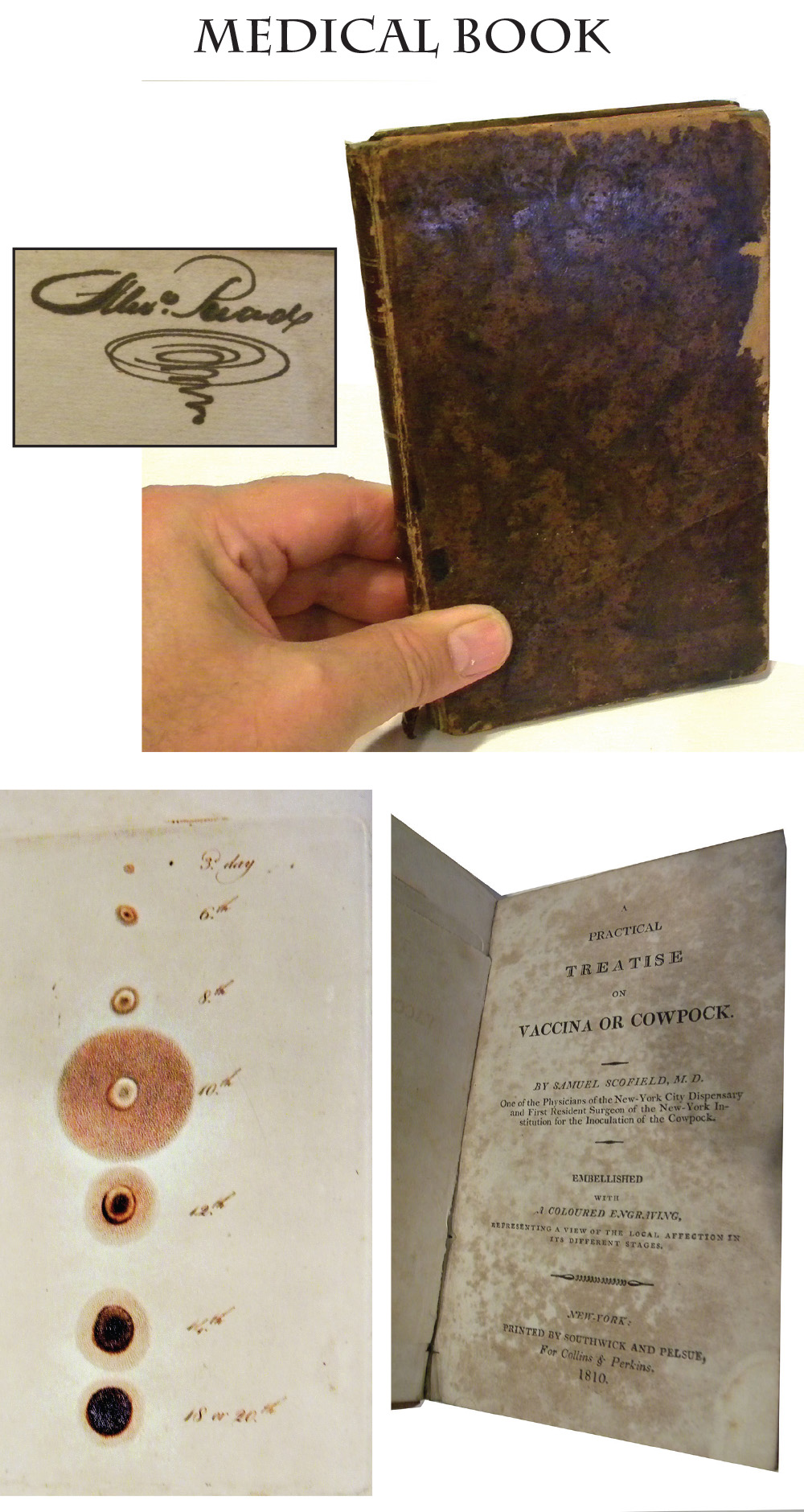
14-11-21 … American Printed – War of 1812 Era – Medical Treatise on Vaccination Against Small Pox …
We forget what a scourge Smallpox was, producing 30 percent and higher mortality rates in severe outbreaks, and scarring survivors for life. It was only officially declared eliminated in 1979. During the Civil War it was one of the big disease killers, affecting far fewer soldiers than measles for instance, but producing just as many deaths. It was just ten years ago that someone turned up actual wartime smallpox samples stored in an envelope in a Civil War medical book! In any case, here is an early publication that tried to spread the word of Edward Jenner s discovery in 1798 that vaccination with cowpox could provide immunity to the disease: A PRACTICAL TREATISE ON VACCINA OR COWPOCK. BY SAMUEL SCOFIELD, M.D. One of the Physicians of the New-York City Dispensary and First Resident Surgeon of the New-York Institution for the Inoculation of the Cowpock. EMBELLISHED WITH A COLOURED ENGRAVING, REPRESENTING A VIEW OF THE LOCAL AFFECTION IN ITS DIFFERENT STAGES. NEW-YORK: PRINTED BY SOUTHWICK AND PELSUE, For Collins & Perkins. 1810. Leather bound, 7 by 4 inches in size, 139 pages. Period owner s signature inside seems to be Alexr. Read. I find a physician named Alexander Reed from New Bedford, Mass., who was well thought of during the period and lived from 1786 to 1849. This could be the owner: the publication date and style of signature certainly match up. Part of Scofield s statement on the importance of the scientific advance was.
THE annals of history do not present to us a discovery of equal importance with that of Vaccination. It is not only intimately connected with the interests and policy of states and empires, but involves, in its consequences, the health and happiness of the whole human race. The story did not end with discovery, however: there was quite a public policy debate for decades on the efficacy of vaccination, whether it should be mandatory, etc. A piece in an antique medical collection and likely often referred to also by military surgeons, who were more often faced with diseases than battle wounds. American printed medical books from this early period are on the VERY scarce side. VG overall
… $375.00 SOLD
Click Here to E-mail Us!
Call us @ 419-842-1863
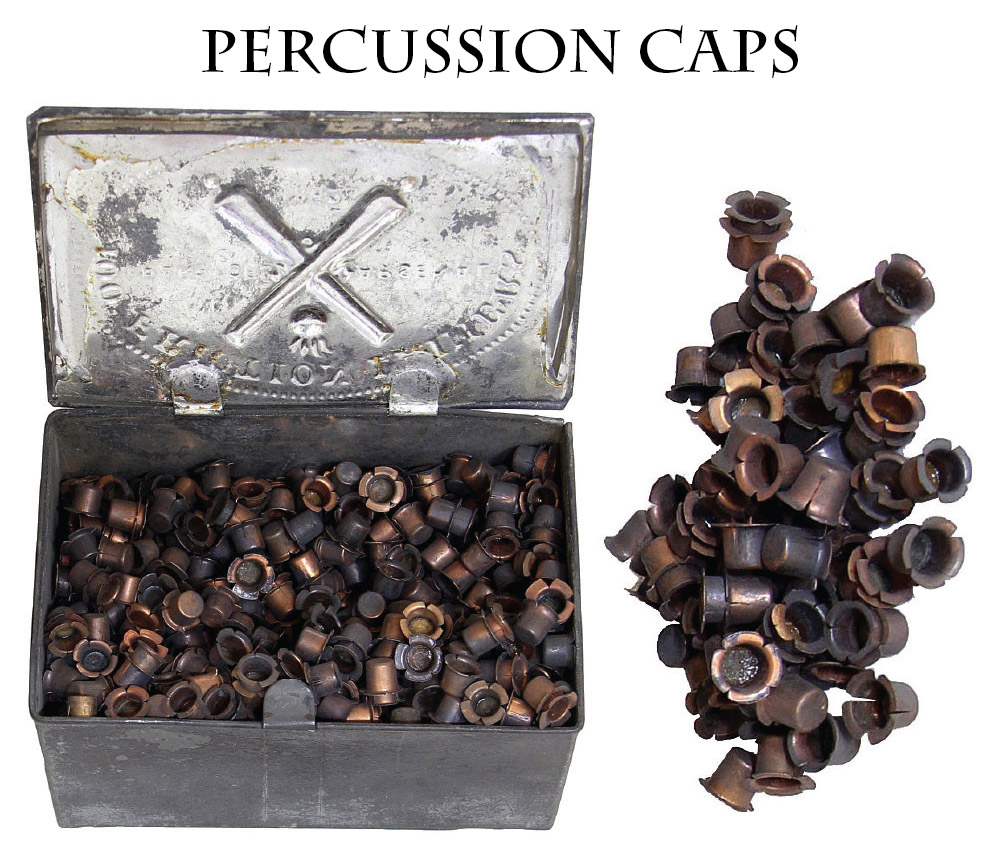
14-11-22 … Friction Primer Tin [ Tin not for sale] and Percussion Caps …
I just purchased this neat old relic and am offering the percussion caps inside the tin in this offering. This very scarce tin came just as you see it, filled with percussion caps for muskets. The tin itself is the arsenal tin used to hold artillery friction primers. These are darned hard to find! I can only think of one instance where I found one still in a primer pouch! The tin has a hinged cover with small latch and embossed top reading: 100 FRICTION PRIMERS in an arc over an ordnance insignia, and FRANKFORD ARSENAL on either side. I don t know who put the percussion caps in the tin, it was certainly a handy storage idea, but since they do not belong together, I am splitting up the lot.
In each package of ten cartridges the soldier got 12 caps. While the supply lasts I will sell the percussion caps …
One Dozen … … … $15
Two Dozen … … … $25
Five dozen … … … $50
Click Here to E-mail Us!
Call us @ 419-842-1863

14-11-24 … 14-09-14 … Double Set Trigger Berdan Sharps Rifle #54511 …
The “holy grail” in Civil War Sharps collecting: a genuine Berdan Model 1859 Sharps Rifle with double set triggers in the proper serial number range. Hiram Berdan ordered 2,000 of these Sharps rifles for his sharpshooters – breech loading for speed and specially equipped with double set triggers for accuracy- one trigger sets the other as a hair-trigger so the trigger pull does not disturb the aim. Berdan rifles fall roughly in the range of high 53000s to low 58000s. Ours is 54511. Note: Some years ago I found a Berdan’s company records book that re-set the known high and low numbers reported by Marcot and Flayderman. If you have a rifle, I’ll be happy to check my numbers for you. This rifle has certainly seen use in the field, as have just about all real Berdans. All the metal was cleaned at some point, leaving scattered gray areas. This is now toning down to a better cooler tone of silvery gray. The wood likewise was cleaned to a lighter brown with darker brown stains. We believe these two factors are significant as the “JT” stock cartouche is nearly completely worn away. A faint rectangle is visible under light with magnification. And the sub inspector’s initial at the breech is likewise nearly completely gone. Both the result of long ago cleaning. Some small shrinkage gaps here and there and a chip out along the top edge of the barrel channel on the right of the forestock from the breech are mentioned for accuracy, but are fairly common and not detrimental to the overall appearance.
The mechanics are good, sling swivels in place, patchbox is functional, and the rear sight is in place. Like the other Berdan example we sold a couple months ago, this too has the 800 yard rear sight as opposed to the 1000 yard sights found on regular Sharps rifles. The marks are what you’d expect … very legible Sharps patent markings on left and right of receiver, New Model 1859 marks at barrel breech, slightly rubbed Sharps manufacturing marks forward of sight, but legible, Lawrence sight patent marks, and clear serial number on tang. The bottom line: not many Civil War weapons can be associated with a specific unit, and far fewer to a unit as elite and as famous as Berdan’s Sharpshooters. They were clothed in green, issued special weapons and equipment, and they served in the Army of the Potomac in all the major campaigns – including Gettysburg, where they were particularly engaged on July 2. This is a dead-real Berdan Sharps that you know was really there. I listed this a few weeks ago at what I felt was a very realistic 7,950. A couple collectors called to talk about it, “thought about it”, but no one committed to purchase. OK in the spirit of upcoming holidays — here it is priced as a gift
… $6,975.00 SOLD
…
ffjj/grcia
Click Here to E-mail Us!
Call us @ 419-842-1863
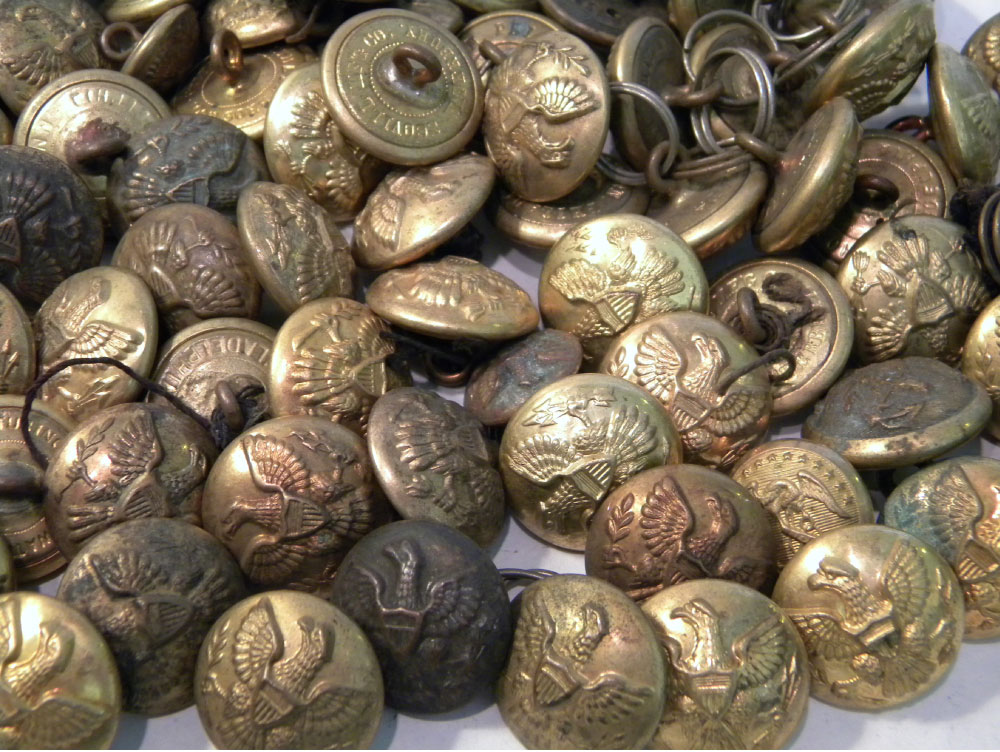
14-11-25 … 12-01-33 – A lot of TEN Original Indian War Large Size Eagle Coat Buttons.
A few years ago at an eastern Pennsylvania auction I bought a couple large bags full of these early Indian Fighters buttons and then I put them aside and forgot about them. I just stumbled across them again …. So here is a great opportunity…. ten original buttons for $25.00 These can be mailed inexpensively in a padded envelope.
… $25.00 for 10
Click Here to E-mail Us!
Call us @ 419-842-1863
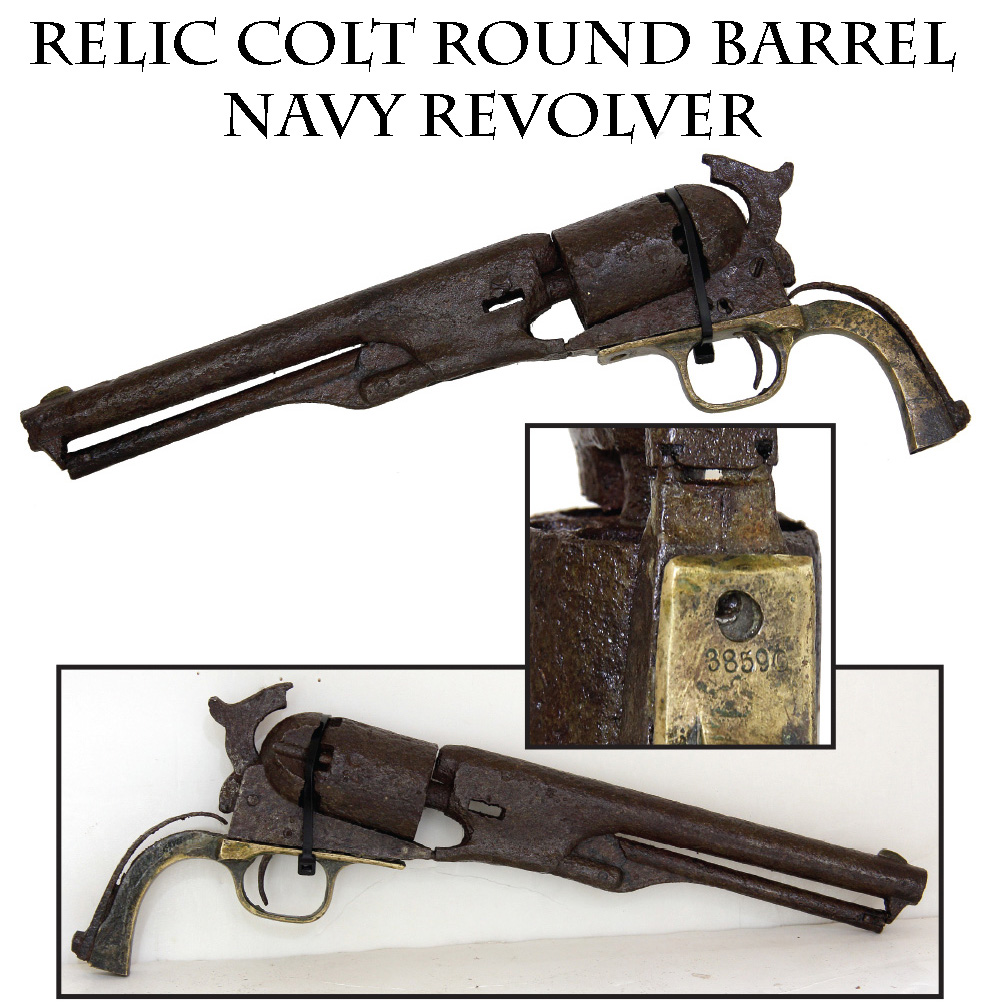
14-11-26 … 14-09-04 … Rare Battlefield Found Model 1861 Colt Round Barrel Navy: …
A very cool cavalry relic – a .36 Colt round barrel navy revolver just as it was dropped by some trooper 150 years ago. The loading lever is in place, hammer partially cocked – making one wonder if the soldier was killed in battle as he tried to cock the gun to defend himself … grips, back strap, wedge and some screws missing, but what a great rustic look! The trigger guard screws are completely corroded so we have a plastic electrical tie holding the trigger guard to the frame. You can secure it better yourself with a thin wire which will display better. Finding a near complete revolver with a metal detector is about 100 times rarer than finding a Confederate buckle. Has very clear serial number 38590
… $495.00 SOLD
Click Here to E-mail Us!
Call us @ 419-842-1863
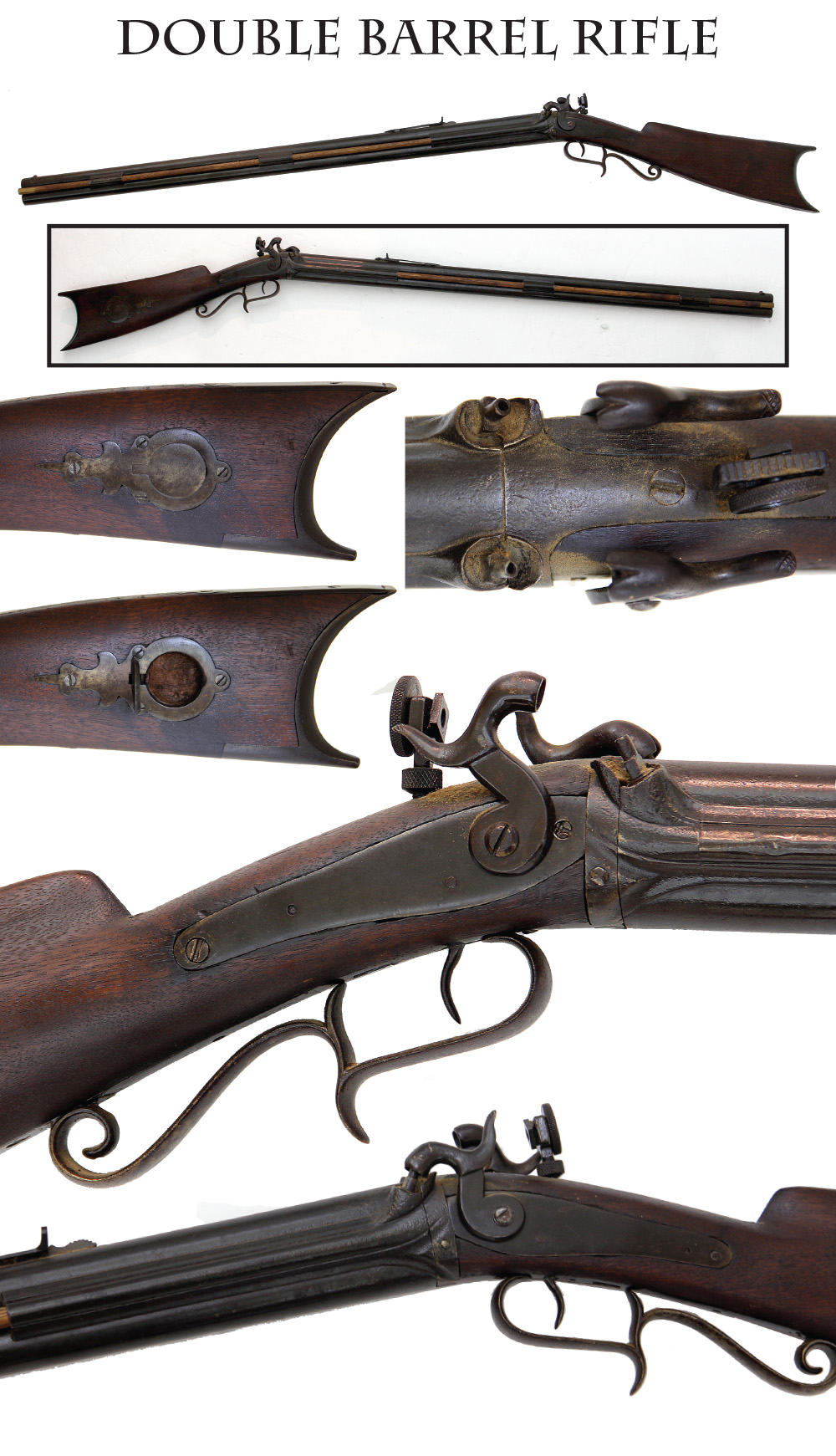
14-11-27 … 14-09-13 … Over and Under Double Barrel Percussion Rifle …
A pleasing 1850s frontier style double rifle. Back-action locks and double hammers give it that extra look of intimidation to go with its hefty weight. The nipples are dirty but not battered down and the wood offers a nice medium brown tone only minor handling marks. A round brass patchbox, butt plate and scrolled trigger guard give the overall look a little extra flair as well. Front and rear barrel mounted sights, and peep sight mounted on the breechplug tang are all present, as are the ramrod thimbles on either side between the barrels. The thimbles capture two brass-capped wood rods. This needs a small bit of basement gunsmithing … the rear trigger is missing so the right hammer is stuck at the cocked position. The forward trigger is fine and te left action functions. Some slight corrosion is present on the breech from firing, and I believe the left hammer screw is an old replacement … otherwise the metal is smooth, with a pleasant barrel browning and age brown mix. A nice look overall and not a tough repair
… $975.00 SOLD
Click Here to E-mail Us!
Call us @ 419-842-1863

14-11-28 … 14-09-21 … M1849 Austrian Rifle and Bayonet …
This Austrian Rifle M1849 Augustin .71 cal. was manufactured by Ferdinand Fruwirth, Vienna, Austria as a standard model 1849 Austrian rifle. This example has a 33″ barrel. They were rifled with 12-grooves and featured a brass butt plate and trigger guard. AKA: Garibaldi rifle. Both the M1842 and the M1849 rifles utilized socket bayonets having long straight “saber” blades, one included with this rifle today as shown. Adapted to standard percussion in the same manner as the M1842 yager rifles, more than 25,000 were sold to the U.S. War Department in 1862 and 1863. Overall Very Good condition. The gun functions perfectrly and shows expected wear and minor pitting is expected with its age. A solid representative example of a scarce import Civil War rifle complete with saber bayonet. … hjj – veg
… $1,150.00 SOLD
Click Here to E-mail Us!
Call us @ 419-842-1863
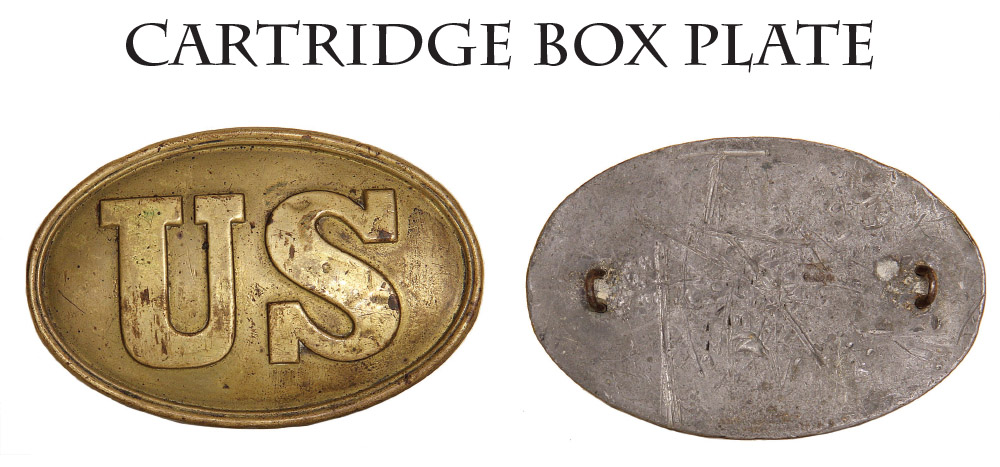
14-11-29 … 14-09-39 … 14-05-10 … Top Notch Cartridge Box Plate … 1861-1865 Regulation …
Identical to the US oval buckles, but having two iron wire loops on the back for securing to the flap of the cartridge box. Fine non-dug condition
with very attractive delicate “mustard” patina
… $210.00 SOLD
Click Here to E-mail Us!
Call us @ 419-842-1863
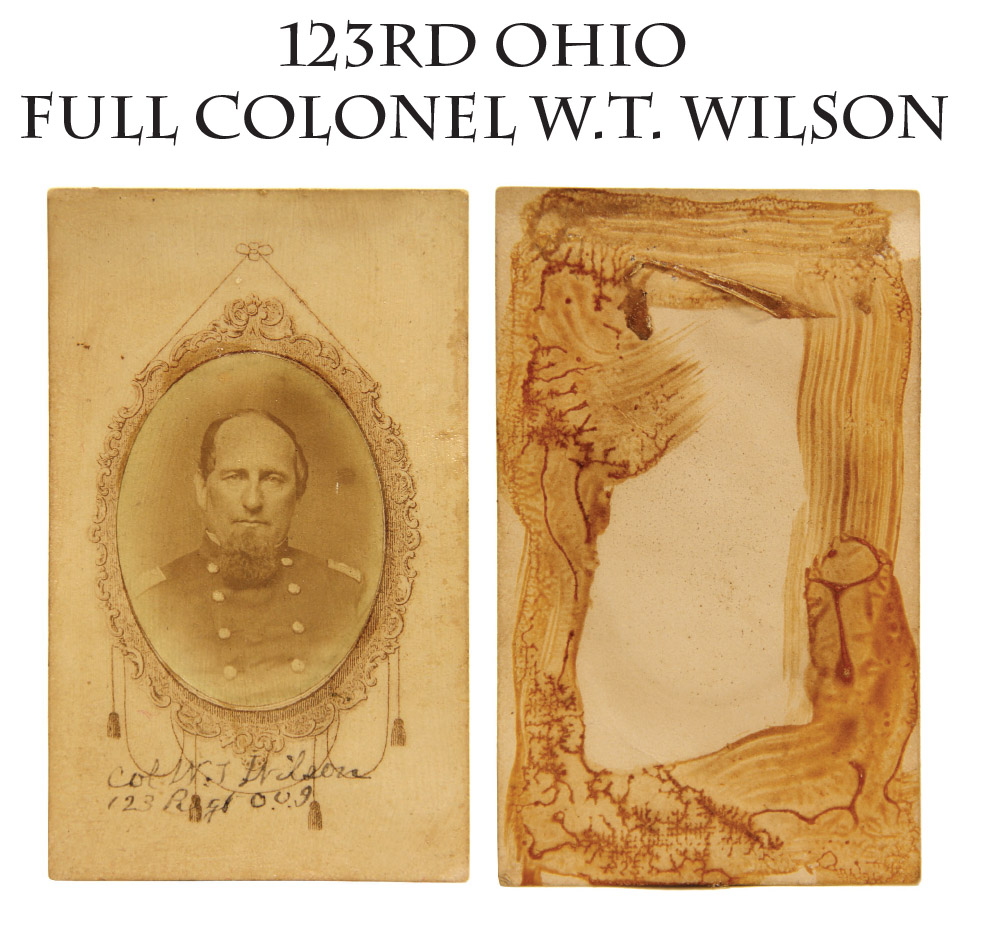
14-11-30 … 14-09-41 … 14-04-29 … Rare Subject ; Brevet Brigadier General William Tecumseh Wilson 15th and 123rd Ohio Infantry:
Vignetted oval bust view in a field-grade officer’s coat mounted on a cdv card with a printed hanging frame to mimic a portrait hung on a wall. Tones a tad light, but clear. Reverse shows glue marks from mounting in an album. Old ink identification bottom front: “Col. W. T. Wilson / 123 Regt O.V.I.” Wilson is a tough Ohio colonel and brigadier general to find in an original 1860s photo. Born in 1823 in Pennsylvania, he apprenticed as a printer and eventually rose to be newspaper publisher and editor. During the Mexican War in enlisted in the Pennsylvania volunteers and participated in the sieges at Vera Cruz and Puebla, and the capture of Mexico City, rocketing up to the rank of fourth corporal by the time of his discharge in 1848. Thereafter he published newspapers in Hollidaysburgh, Pennsylvania, and then in Blair County, Ohio. When war broke out, he enlisted at age 35 on 4/23/61 and was commissioned Captain of Co. C 15th Ohio Volunteer Militia on 4/27/61. This was one of the first Ohio regiments, enrolled for three-month’s service, and was sent to West Virginia. There they did guard duty, but also served on a number of expeditions and took part in the actions at Philippi, Laurel Hill and Carrick’s Ford. After the regiment was mustered out, Wilson was promoted on 8/6/61 to Lt. Colonel of the 15th Ohio Volunteers, a three-year outfit assigned to the Army of the Ohio, which first saw action at Shiloh in April, 1862, losing 6 killed and 62 wounded under command of the regiment’s major. Wilson must have been well regarded, however, he was discharged from the 15th OVI on 9/26/62 for promotion to Colonel of the 123rd Ohio on 9/26/62, which again placed him in western Virginia. The regiment’s first real action was during Lee’s advance north in the Gettysburg campaign when they fought General Early at Winchester, losing some 100 men before being compelled to surrender the next day, 6/15/63, with the rest of the brigade. Wilson was confined at Macon and at Columbia, before being paroled 3/18/64 and officially exchanged 5/28/64. The regiment saw more action at Lynchburg, Snicker’s Ferry, Winchester, Berryville and other locations, facing off against Early several more times. Only at Opequon, Fisher’s Hill and Cedar Creek did they begin to taste victory and thereafter went to Bermuda Hundred and the siege of Petersburg, where they eventually gained credit for capturing two enemy flags. It was irony that their last action was the Battle of High Bridge in the pursuit of Lee, where they were hit from the rear by Confederate cavalry and once again became prisoners of war. Wilson mustered out with the regiment on 6/12/65. During their service they had suffered heavily, losing 91 officers and men killed or mortally wounded. Wilson served as Comptroller of the Treasury in Ohio and also as mayor of Upper Sandusky. He died at Columbus, Ohio, in 1905. Extremely scarce subject
… $135.00
Click Here to E-mail Us!
Call us @ 419-842-1863

14-11-31 … 14-09-44 … 14-04-31 … Special Aide to Lincoln / African American Related / Signed CDV of Colonel Le Grand Bouton Cannon, Aide-de-Camp to General Wool, influential in the Union Defense Committee in 1861,
the sheltering of escaped slaves at Fortress Monroe, the enlisting of black troops in the army, and internal army politics. Crisp vignetted bust view of a field-grade officer with flashy sideburns! Cannon was from New York and had served as a volunteer on General Wool’s staff before the Civil War. When most of Wool’s staff resigned and went south, Cannon and a few other prominent New Yorkers joined his staff as volunteers, Cannon acting a volunteer ADC to Wool from April 23 to August 28, 1861. During this period he took an active part in the Union Defense Committee of New York in corresponding with and aiding various northern governors, like the Governor of Illinois, who were trying to obtain arms, etc., and organize without adequate leadership from Washington.
Cannon was officially appointed Major and AADC on Wool’s staff August 28; and Colonel on Feb. 1, 1862. He accompanied Wool to Fortress Monroe, Virginia, which they preserved for the Union. Cannon was involved in formulating the “contraband” policy about escaped slaves who had sought protection at Fortress Monroe and was intimately involved in some of the army’s political infighting. His reminiscences published after the war include a number of first hand accounts of the Monitor and the Merrimac, time spent as a special aide to Lincoln, and experiences with Secretary Stanton, etc. Cannon resigned June 11, 1862, but rejoined Wool’s staff as a volunteer for a time thereafter, until Wool’s retirement in 1863. Cannon’s accounts are a real insider’s view of the doings at various army headquarters. He had been offered the military command of Norfolk, before resigning.
The card is presented to Lt. Col. Whipple, who is probably William Dennison Whipple, West Point class of 1847, who served until 1890, was both ADC and AAG at different points in his career, served on Gen. Hunter’s staff, the staff of General Thomas, and after the war as ADC to Sherman from 1873 to 1878: “Lt. Col. Whipple USA / Asst Adjt Genl / With regards / Le GB Cannon Col / USA & ADC.” Their staff duties had probably brought them into connection at some point, though Whipple was a New Yorker like Cannon.
A significant subject involved in some important early war doings
… $150.00
Click Here to E-mail Us!
Call us @ 419-842-1863

14-11-32 … 14-09-45 … 14-04-33 … General William F. Smith—He spoke his mind!
Wonderful half-length seated view of the outspoken general in his major-general’s frock coat. Couple minor abrasions to card edge, otherwise excellent. “Baldy Smith” was West Point class of 1845, an officer of engineers until the Civil War, and Colonel of the 3rd Vermont in 1861 serving on the staff of General McDowell at Bull Run. He became a Brigadier General of Volunteers in 1861 and led a division of the 6th Corps on the Peninsula and the Maryland Campaign, and commanded the corps at Fredericksburg. Critical of Burnside and a supporter of McClellan, he was shunted aside in 1863 and sent west, where he ended up feuding with Rosecrans but earning some praise from Grant, and made Major General in 1864. Brought east to command the 18th Corps under Butler, he criticized both Butler and eventually Meade. Accusations that he could have acted more aggressively at Petersburg led to his removal from command in July, 1864. He left the army in 1867, turning to civil engineering and acting as president of a telegraph company and the NY Board of Police Commissioners until his death in 1903. My favorite quote of his was his judgment on Butler: “as helpless as a child on the field of battle and as visionary as an opium eater in council.” He cerrtainly knew how to craft a criticism
… $95.00
Click Here to E-mail Us!
Call us @ 419-842-1863
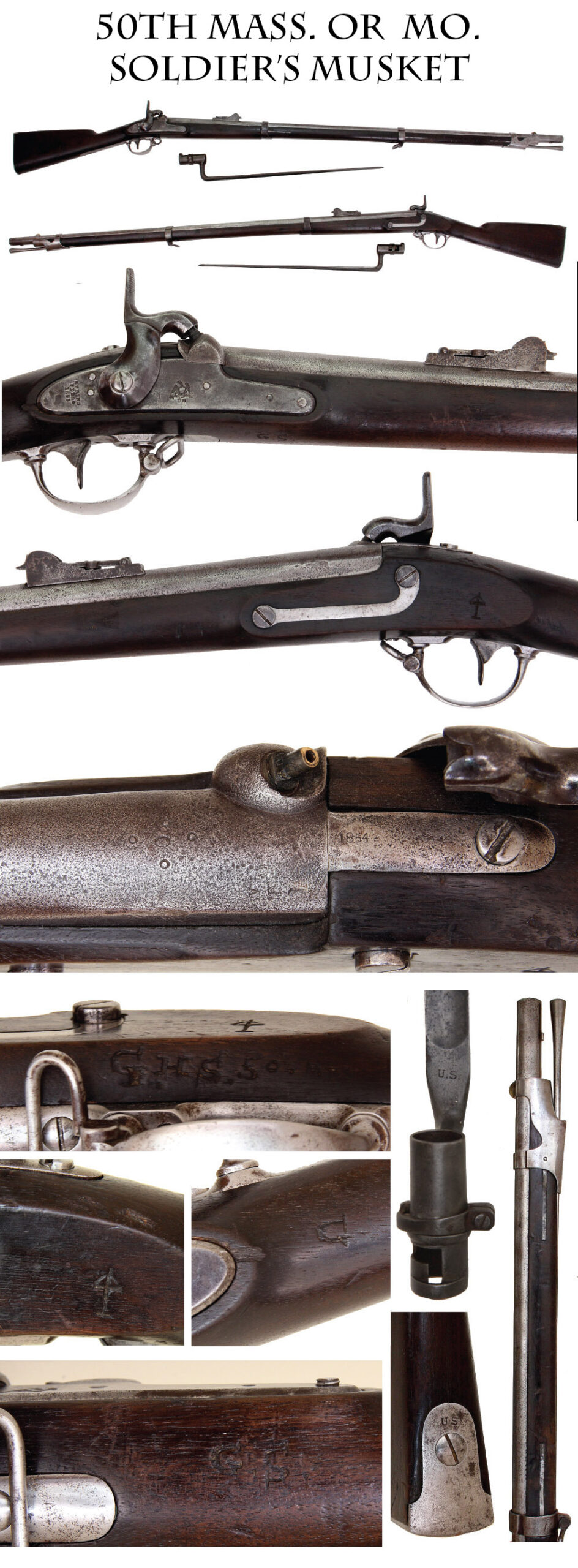
14-11-33 … Likely 50th Mass. Soldier Carved – Rifled and Sighted Springfield 1842 Pattern Musket and Bayonet …
A very nice example of one the last smooth bore muskets made and likely one of the first to be rifled. When the 1855 series of arms introduced rifling for all shoulder arms, there was a rush to retrofit older smooth bores. Cone-in-barrel percussion conversions could not withstand the higher pressures caused by the new minie rounds until the breeches were changed, but the 1842 pattern smooth bore muskets could handle the new ammunition and moved to the head of the line for rifling at the arsenals, some being given the 1855 pattern long range rear sight as well. Ours is a very nice example of the rifled and sighted ’42. Overall the metal shows armory bright, as is correct, the lock plate having clear Springfield 1853 marks at rear and the Springfield eagle/US forward. Lock plate and hammer are smooth with smokey gray over silver. The barrel is generally a tad lighter silver/gray with an overlay of that powdery dark gray tiny dimpling from exposure and use, but with clear V/P/eagle proofs and clear 1854 date on the breechplug tang. The mismatched dates are TOTALLY CORRECT on a “rifled and sighted” model 1842. The guns were disassembled and the parts sorted without regard to which gun they came off of. The barrels were rifled, some were given long range sights as this one has, all steel parts were refurbished, and then the muskets were reassembled without regard to whether the dates matched. What makes this musket so interesting are the added markings put on by the soldier. Four small circles have been stamped around a central oval just forward of the bolster on the top of their barrel. This may be a rough representation of a Catholic symbol based on Jesus in a central circle surrounded by four other circles containing crosses and two human figures in each. Further evidence of religious symbolism is a clearly carved Christian cross on the left side flat, This cross has a Celtic flavor with half a circle incised above the cross arms. The traditional Celtic cross bears a complete circle, but this seems very close. The initials GS and GHS next to a 50 M.. have been deeply carved on the underside near the triggerguard, another G to rear of the lock. Research was as follows… 50 M assumed to represent the unit designation… There are only two states beginning with the letter “M” that also have 50 regiments of infantry. These are Massachusetts and Missouri. Each state has one soldier bearing the initials GHS in their 50th Regiments. The least likely in my opinion is George H Shephard who enlisted 9/15/1864 and has no record of date of discharge. The more likely owner in my opinion is George H. Spofford a 28 year old shoe cutter from Georgetown, Mass. He enlisted in the 50th Mass 9/19/62 and served his entire term of service until 8/24/63 when the entire regiment was mustered out of service. He then rejoined the 17th Unattached Company of infantry and served again from late 1864 through June of 1865. I believe the Catholic and Celtic symbols on the gun are more likely done by someone from the densely Catholic state of Massachusetts… though Missouri did have 4,362 Catholics residing there when the Civil War broke out according www.theCatholicthing.org.
The 50th Mass. has a decent history. The 50th left for New York, Nov. 19, 1862 arriving the following day, and being almost immediately ordered thence to Camp Banks, Long Island, the rendezvous of the Banks expedition to Louisiana. The regiment was conveyed from Fort Monroe to Louisiana in fragments. At Baton Rouge the regiment was assigned to Dudley’s (3d) Brigade, Augur’s (1st) Division, l9th Corps, and before the arrival of the last three companies it had, on March 14, taken part in the demonstration against Port Hudson, made in cooperation with Farragut’s fleet, two vessels of which, the HARTFORD and the ALBATROSS, succeeded in passing the Port Hudson batteries and securing a position on the river above the city. From this time until March 26, the regiment was at Winter’s plantation on the west bank of the Mississippi about three miles below Port Hudson. On the latter date it returned to Baton Rouge. On May 12 the regiment proceeded to White’s Bayou about ten miles southeast from Port Hudson where it remained until the 26th when it moved up to the works in front of the city. It took part in the assault on Port Hudson, May 27, its losses, however, being slight. It did not participate in the second assault, June 14, but was engaged in supporting batteries and in trench duty until the surrender of the city, July 9. From this time on for about twenty days it was in Port Hudson doing guard duty. On July 29 it boarded the steamer OMAHA bound for Cairo, Ill., en route for home. At Helena, Ark., the boat grounded on a sand bar, and the regiment was transferred to the steamer L. M. KENNETT, reaching Cairo, Aug.5. Here it entrained for Massachusetts, reaching Boston, Aug. 11. After a collation at Beach Street Barracks the regiment was marched to the Common and there dismissed, to reassemble at Wenham Mass., August 24.where it was formally mustered out of the United States service.Overall VG condition. Nipple is in good shape, some signs of use, but not battered. 1855 pattern long range rear sight with ladder is in place. Wood has a pleasing dark, uniform tone, and pretty sharp edges around the lock and sideplate, but the gun did see action: some minor dings overall and one small chip at the rear point of the lockplate. All bands, swivels and springs are in place, as is the front sight and bayonet stud. Rod is the correct rod for a 42, and is the first pattern ’42 rod. We also have the correct bayonet: good US marking, functional locking ring, etc. A scarce gun in its own right and even better with the tangible carving which reveals the history
… $1,950.00
Click Here to E-mail Us!
Call us @ 419-842-1863
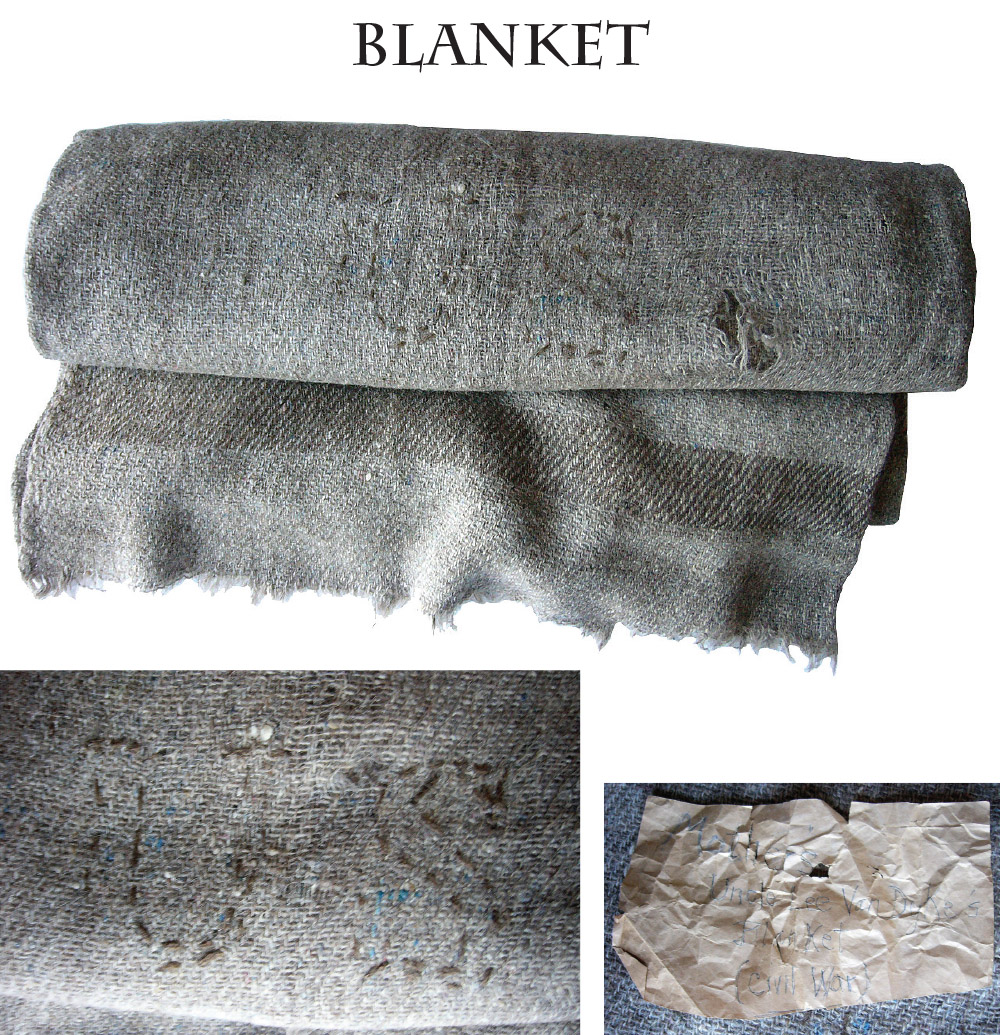
14-11-34 … A Real Civil War US Army Issue Blanket Id d to a New York Soldier:
Standard army pattern utilizing very loose, coarsely woven, twill (diagonal weave) wool with plenty of shoddy mixed in. This being bits and pieces of scrap wool used by makers to cut costs. About 80 by 70 inches, (they were roughly 80″ x 65″ fresh off the looms.) We have gained a few inches of stretch after 150 years. Standard unbound ends with dark stripes running across the width. And the magic part …. the loosely woven US in the center executed in brown wool yarn. Brownish gray overall with darker brown end stripes 2 1/4 inches wide running across the blanket 4-6 inches from each end, closer on the bottom because of edge wear and fraying. Large U.S. in brown yarn about the same color as the end stripes, and measuring 4 inches by 4 inches. Wear spots about the size of the palm of one s hand to right of the US, and a couple of others on the lower left, some areas of thinning fabric and several small holes, but generally very solid, able to be handled and displayed open or rolled. We used a white background in places to highlight the wear. It is nowhere near as noticeable in person. This blanket surfaced decades ago in upstate New York and has a family note on a scrap of brown paper probably written in the mid 20th century, identifying it as Uncle Lee Van Dyke s Civil War Blanket. The name checks out as Levi S. Vandycke, who served in the 142nd New York from September, 1862, to September, 1864, and was wounded 7/6/64 at Petersburg. The regiment saw some hard fighting, losing 3 officers and 126 men killed or mortally wounded. They served in several different corps, including the 11th, 10th, and 18th, and saw action at Drewry s Bluff, Bermuda Hundred, Cold Harbor, and Petersburg during Vandycke s period of service. They saw their last fighting at Fort Fisher in 1865, but that was after Vandycke had been discharged, perhaps as a result of his wounds. A rare issue item
… $2,850.00 SOLD
Click Here to E-mail Us!
Call us @ 419-842-1863
Layaways are Welcome
Need to split your order into multiple payments? No problem! A simple 20% earnest money deposit will hold your item for you.-acf
You can then pay it off in easy installments that fit your budget.
Read Terms Here
Items to Sell? Contact Us
I am always interested in buying ANYTHING from the American Civil War… Guns, Swords, Civil War Muskets, Knives, Uniforms, Flags, Medals, Badges, Diaries, Letters, Autographs, Buttons, photographs, tintypes, daguerreotypes, Insignia, Camp Items, Battlefield Relics, canteens, Drums, Etc… Call 419-842-1863 and ask for Dave Taylor.

